



|
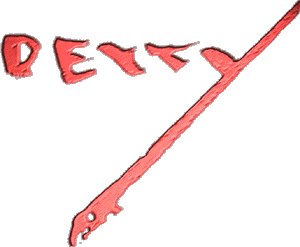 |
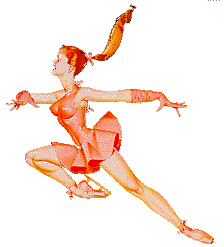
|
| George Petty is most famous for his pin-up drawings that appeared in Esquire magazine in the 1930's and the covers for many Ice Capades programs. There is an excellent 1997 book on him, Petty - The Classic Pin-Up Art of George Petty. It's worth getting and I hereby credit it as my main source of information on Petty. |
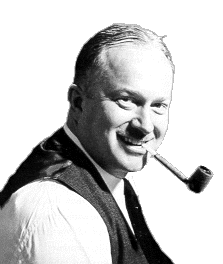
|
Petty was born in 1894 in Louisiana, the son of a photographer,
also named George, who moved his family to the potentially more
prosperous Chicago around 1900. George survived traditional schooling,
though he thrived at evening classes at the Chicago Art Institute.
He spent a great deal of time in his father's photography studio
where he mastered the airbrush, a tool invented around 1889 and
used solely to retouch photographs (or their negatives). Petty
would help change that. Prior to World War I, study in Europe was de rigueur for the aspiring artist. After his graduation from high school, Petty's mother took George and his sister to Paris where he was enrolled at the Académie Julian. This art school was quite famous and had such illustrious alumni as John Singer Sargent, Alfonse Mucha, Matisse, and, most significant to Petty, J.C. Leyendecker. George studied in Paris until 1916, then returned to Chicago. At the age of 18, he should have been prime fodder for the War, but shortly after Petty's return from Europe, his father died, leaving George the head of the family and so exempt from service. |
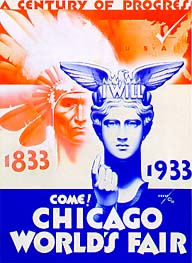 |
Not wanting to be a photographer or a photo-retoucher, he closed his father's studio and went to work for an ad agency, where his first published work was a stylish ice skater on the cover of the 1920 Marshall Field catalog (at right). Ice skaters were to figure prominently in his future. At the agencies, Petty excelled at retouching and his skill with the airbrush was prodigious. He did lots and lots of retouching, all the while focusing his efforts on breaking into the illustration market. There were plenty of advertisements, but his few covers and magazine assignments led nowhere. He began using the airbrush in his drawings, not a common medium at the time, but the results were stunning, like the poster at left that won Petty first prize in the 1933 Chicago World's Fair poster contest. |
 |
 In the early Thirties, George opened
his own studio and started to get more and more work that relied
on pretty women. His daughter Marjorie Jule, born in 1919, was
modeling for him and her body topped with an endless variety of
faces would appear in many of these ads. In 1933, the depths of
the depression, Esquire Magazine was started. At a time
when The Saturday Evening Post was a nickel, The Ladies
Home Journal a dime, and Good Housekeeping and Cosmopolitan
a quarter, Esquire debuted at 50 cents. Only Fortune,
started in 1930, just three months after the stock market crash,
was priced higher at $1. And just as Fortune had confounded
the prophets by being successful, Esquire's first issue
sold out - even with a print run of 100,000.
In the early Thirties, George opened
his own studio and started to get more and more work that relied
on pretty women. His daughter Marjorie Jule, born in 1919, was
modeling for him and her body topped with an endless variety of
faces would appear in many of these ads. In 1933, the depths of
the depression, Esquire Magazine was started. At a time
when The Saturday Evening Post was a nickel, The Ladies
Home Journal a dime, and Good Housekeeping and Cosmopolitan
a quarter, Esquire debuted at 50 cents. Only Fortune,
started in 1930, just three months after the stock market crash,
was priced higher at $1. And just as Fortune had confounded
the prophets by being successful, Esquire's first issue
sold out - even with a print run of 100,000.
Petty's work was in that first issue, a cartoon. He wasn't a cartoonist, but that's what the magazine needed and they were willing to supply him with situations and gags. The drawings he submitted were printed full page on good paper and the magazine's 10"x14" format was perfect for the slick, well-rendered images George was capable of. With his command of the airbrush, a strong foundation in drawing, plenty of practice drawing lissome women, and a willing model, Petty had assembled the components of a meteoric career. His cartoons appeared in seven of the first dozen issues and were thinly disguised excuses for rendering the female body. Even when they were fully clothed, his women looked like, if you'll pardon the expression, their clothes were airbrushed on.Witness the "cartoon" at above right from a 1935 issue and also issued as part of a spiral-bound portfolio of Petty cartoons from 1937 titled aptly enough, Petty - A Portfolio. Click for larger image.
|
The exposure brought Petty to the attention of national ad agencies and within two years George was doing monthly ads for Old Gold Cigarettes and Jantzen Swim Wear as well as others, many of which appeared in the same issues of Esquire as his cartoons. The cartoons were a huge success. Quickly dubbed The Petty Girl, the public clamored for more of her and Esquire was more than happy to oblige. With its high production values, the magazine was able to add fold-outs as a design feature. In the Christmas, 1939 issue, one (of four) of these was devoted to the largest Petty Girl yet seen. That's about 1/2 of her at the right. Fully 30" long, the modern pin-up was born and Esquire's circulation soared yet again. |
 |
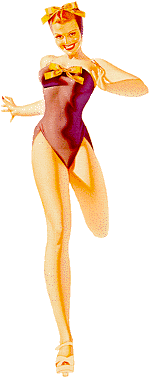 It's
rather difficult to convey just how famous Petty became - and
how fast! This rather obscure Chicago commercial artist was suddenly
thrust upon the national stage, literally, overnight. His signature
was prominently displayed in all of his advertising work. Jantzen
created the "Petty Girl" swimsuit in 1940. Old Gold
offered prints of the Petty Girls in their ads. His hands, a brush,
and Petty Girl appeared in a watch ad. He was given highly publicized
commissions to paint posters for films. The aforementioned portfolio
was released. In 1942, when 3700 Chicago high school art students
cast their votes for most important artist from their three years
of art studies, Petty won first place - as a write-in. He did
a cover for Time in 1942 as well as the first in a line
of covers for the annual Ice Capades revue. And it would be incorrect
to attribute all the fame to the Esquire pin-ups. If anything,
it was his national advertising images that got him the most attention
- and money.
It's
rather difficult to convey just how famous Petty became - and
how fast! This rather obscure Chicago commercial artist was suddenly
thrust upon the national stage, literally, overnight. His signature
was prominently displayed in all of his advertising work. Jantzen
created the "Petty Girl" swimsuit in 1940. Old Gold
offered prints of the Petty Girls in their ads. His hands, a brush,
and Petty Girl appeared in a watch ad. He was given highly publicized
commissions to paint posters for films. The aforementioned portfolio
was released. In 1942, when 3700 Chicago high school art students
cast their votes for most important artist from their three years
of art studies, Petty won first place - as a write-in. He did
a cover for Time in 1942 as well as the first in a line
of covers for the annual Ice Capades revue. And it would be incorrect
to attribute all the fame to the Esquire pin-ups. If anything,
it was his national advertising images that got him the most attention
- and money.
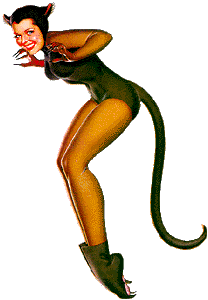 It
was money that finally severed the Esquire relationship.
The money Esquire paid bought less and less of Petty's
time as his advertising career soared. Alberto Vargas had been brought in as a replacement
during negotiations and in 1942, after a year of uneasy coexistence,
the Petty Girl made way for the Varga Girl in Esquire,
anyway. Petty continued his high-profile commercial art and spent
the war years doing ads and posters (see "It's for YOU..."
below). In 1945, he began a three year alliance with little-known
True Magazine and helped them double their circulation.
While many of the images still retained his trademark telephone,
he was beginning to branch out into more lively poses as the True
page above left and "The Panther Girl" (at right) done
for the 1946 Ziegfield Follies clearly show.
It
was money that finally severed the Esquire relationship.
The money Esquire paid bought less and less of Petty's
time as his advertising career soared. Alberto Vargas had been brought in as a replacement
during negotiations and in 1942, after a year of uneasy coexistence,
the Petty Girl made way for the Varga Girl in Esquire,
anyway. Petty continued his high-profile commercial art and spent
the war years doing ads and posters (see "It's for YOU..."
below). In 1945, he began a three year alliance with little-known
True Magazine and helped them double their circulation.
While many of the images still retained his trademark telephone,
he was beginning to branch out into more lively poses as the True
page above left and "The Panther Girl" (at right) done
for the 1946 Ziegfield Follies clearly show.
 Petty
had always been a sharp businessman and insisted on retaining
all secondary rights to his images as well as the return of his
original paintings. He licensed their use on playing cards, on
drinking glasses, and elsewhere. At left is from an ad I just found
in a 1943 issue of The
American Weekly wherein for $2 sent directly to Petty, you'd
get a set of four 12"x18" posters printed in six colors!
Petty
had always been a sharp businessman and insisted on retaining
all secondary rights to his images as well as the return of his
original paintings. He licensed their use on playing cards, on
drinking glasses, and elsewhere. At left is from an ad I just found
in a 1943 issue of The
American Weekly wherein for $2 sent directly to Petty, you'd
get a set of four 12"x18" posters printed in six colors!
And he never ceased working. He did a calendar for Ridge Tools in 1953. He returned to Esquire with a 1955 calendar, designed the hood ornaments for the 1954 and 1955 Nash automobiles and in the early Sixties was back doing paintings for The Ice Capades. Petty died in 1975 after witnessing a minor revival of his work, including a new pin-up for the 40th anniversary issue of Esquire.
 To learn more about George Petty, see:
To learn more about George Petty, see:| Petty - The Classic Pin-Up Art of George Petty | Reid Stewart Austin, 1997 Gramercy |
| The Vadeboncoeur Collection of Knowledge | Jim Vadeboncoeur, Jr. 1999 |
|
Illustrations are copyright by their
respective owners. This page written, designed & © 1999 by Jim Vadeboncoeur, Jr. Updated 2011. |
